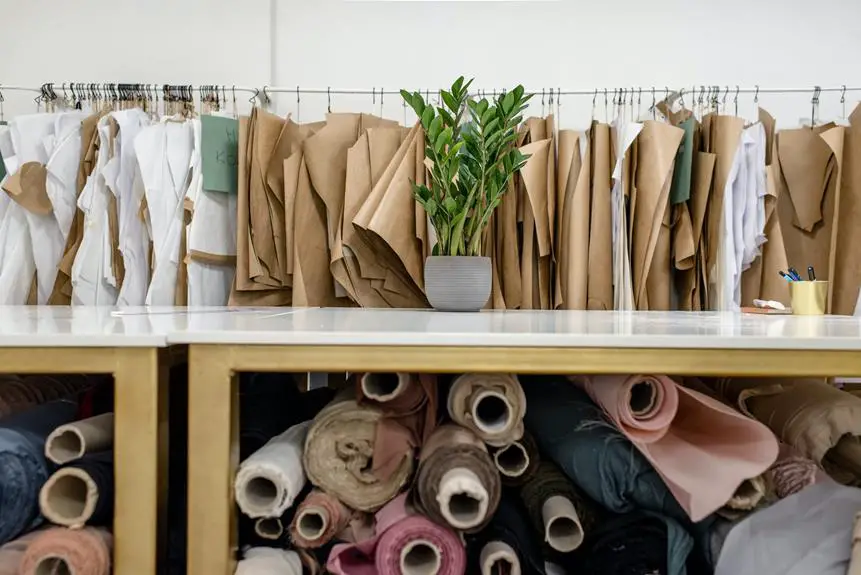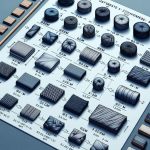Are you aware that the weight of fabric is often measured in grams per square meter (GSM)? Understanding GSM can significantly impact your fabric selection.
When it comes to choosing the right fabric for your project, 10 oz fabric is a popular choice, but is it the best choice for you? Exploring the ins and outs of GSM and fabric weight measurements can help you make an informed decision.
In this guide, we'll delve into the pros and cons of 10 oz fabric, compare it with other GSM options, and provide tips for working with this weight of fabric. By the end, you'll have a comprehensive understanding of whether 10 oz fabric is the right choice for your needs.
Key Takeaways
- GSM is a measurement of the weight and density of fabric, indicating how many grams one square meter of fabric weighs.
- Fabrics with higher GSM values are generally thicker and more durable, while lower GSM fabrics are lighter and more breathable.
- 10 oz fabric offers a balance between durability and lightweight comfort, making it versatile for heavy-duty workwear, bags, outdoor gear, and upholstery.
- When selecting fabric for a project, consider the specific requirements, intended use, breathability, drape, and texture needed.
What Is GSM and Its Significance
Understanding GSM and its significance is essential when choosing the right fabric weight for your needs.
GSM, or grams per square meter, is a measurement of the weight and density of a fabric. It indicates how many grams one square meter of fabric weighs. This measurement is crucial in determining the fabric's thickness, durability, and overall quality.
When selecting fabric, considering GSM is vital as it directly impacts the fabric's performance and suitability for various purposes. Fabrics with higher GSM values are generally thicker, more durable, and warmer, making them suitable for heavy-duty applications such as upholstery or winter clothing. On the other hand, lower GSM fabrics are lighter, more breathable, and suitable for summer wear or drapery.
Understanding GSM allows you to make informed decisions about the type of fabric that will best suit your intended use. Whether you're choosing fabric for clothing, home decor, or industrial purposes, being knowledgeable about GSM empowers you to select the most appropriate material for your specific needs.
Understanding Fabric Weight Measurements
When considering fabric weight measurements, you need to understand how they relate to GSM and their impact on the fabric's suitability for different purposes. Fabric weight is typically measured in ounces per square yard (oz/yd²) or grams per square meter (GSM), which are the two most common measurement units. Understanding these units is crucial for determining the fabric's density and, consequently, its suitability for various applications.
| Measurement Unit | Abbreviation | Conversion Factor |
|---|---|---|
| Ounces per Square Yard | oz/yd² | 33.906 |
| Grams per Square Meter | GSM | 0.0295 |
The conversion factor between these units is essential for comparing fabric weights across different measurement systems. Fabric density calculations rely on these measurements to determine the thickness, durability, and potential uses of the fabric. By understanding fabric weight measurements and their significance in fabric density calculations, you can make informed decisions about the most suitable fabrics for specific projects or products.
Evaluating 10 Oz Fabric: Pros and Cons
When considering 10 oz fabric, it's important to weigh the benefits and drawbacks.
The fabric's weight and durability are key factors to consider, as well as its versatility in various applications.
Additionally, conducting a cost-effectiveness analysis will provide insight into the fabric's overall value.
Weight and Durability
You can evaluate 10 oz fabric for its weight and durability to determine its pros and cons. When considering weight, 10 oz fabric offers a balance between being substantial enough for durability while still being lightweight and comfortable. However, the durability of 10 oz fabric depends on the specific material and textile technology used. Here's a table to help you understand the pros and cons:
| Aspect | Pros | Cons |
|---|---|---|
| Weight | – Substantial for durability | – May be too heavy for certain applications |
| Durability | – Offers good resilience | – Depends on material and textile technology used |
| Comfort | – Balances weight and comfort | – May feel too heavy for some preferences |
Understanding these factors can help you make an informed decision about whether 10 oz fabric is the right choice for your specific needs.
Versatility in Applications
For evaluating 10 oz fabric's versatility in applications, consider its suitability for various uses.
The 10 oz fabric's weight and durability make it well-suited for a wide range of applications. Its versatility allows it to be used in heavy-duty workwear, durable bags, outdoor gear, and upholstery.
The fabric's weight provides a balance between sturdiness and flexibility, making it an excellent choice for items that require both strength and comfort. Its durability ensures that it can withstand frequent use and maintain its quality over time.
However, the weight may not be suitable for lighter clothing or delicate items where a lighter fabric is preferred. Understanding the specific requirements of different applications is crucial in determining whether 10 oz fabric is the right choice for a particular project.
Cost-Effectiveness Analysis
Evaluating the cost-effectiveness of 10 oz fabric involves considering its pros and cons in various applications. When conducting a cost analysis, it's important to factor in the fabric thickness.
The thicker 10 oz fabric typically provides better durability and longevity, potentially reducing the need for frequent replacements. This can result in long-term cost savings, especially in applications that require sturdy materials.
However, it's essential to weigh this against the initial investment, as thicker fabric may come at a higher price. Additionally, the weight of 10 oz fabric may impact shipping costs, affecting overall expenses.
Understanding the specific requirements of your project and weighing the long-term benefits against initial costs is crucial in determining the cost-effectiveness of 10 oz fabric for your particular application.
Selecting the Right GSM for Your Project
When choosing the right GSM for your project, consider the specific requirements and intended use of the fabric. Start by evaluating the GSM comparison to understand the weight and thickness that will best suit your needs.
For heavy-duty applications such as upholstery or bags, a higher GSM (grams per square meter) fabric would offer more durability and strength. On the other hand, lighter GSM fabrics are suitable for clothing and drapery where a softer, more flexible material is desired.
Additionally, fabric selection should take into account the breathability, drape, and texture required for the project. For example, a lower GSM fabric may be preferable for a summer dress due to its lighter weight and breathability. Conversely, a higher GSM fabric could be ideal for creating structured garments.
Comparing 10 Oz Fabric With Other GSM Options
When considering fabric GSM options, it's essential to compare 10 oz fabric with other choices, such as 8 oz, to determine the best fit for your project.
Quality should take precedence over quantity, so evaluating the fabric's GSM is crucial for achieving the desired outcome.
Understanding the differences between 10 oz and 8 oz fabrics will help you make an informed decision for your specific needs.
10 Oz Vs 8 Oz
Comparing 10 oz fabric with other GSM options can help you determine the best choice for your specific needs. When considering 10 oz fabric versus 8 oz fabric, there are several key factors to take into account:
- Fabric Density: 10 oz fabric offers a higher fabric density compared to 8 oz fabric, providing better durability and strength.
- Weight and Thickness: While 10 oz fabric is heavier and thicker, 8 oz fabric is lighter and more suitable for applications requiring less bulk.
- Cost and Efficiency: 10 oz fabric may be more expensive than 8 oz fabric due to the higher density, but it can also offer greater efficiency and longevity in certain applications.
Understanding these differences will allow you to make an informed decision based on your specific requirements, whether it's for industrial, commercial, or personal use.
Quality Over Quantity
To fully assess the quality over quantity aspect when choosing 10 oz fabric or other GSM options, consider the specific requirements for your intended application.
Quality assessment is crucial when comparing different GSM options. While 10 oz fabric may offer a certain level of thickness and durability, it's essential to also evaluate the material composition.
Some applications may benefit from a lighter GSM with a specific blend of materials, while others may require the heft and sturdiness that 10 oz fabric provides. Examining the intended use, environmental factors, and performance expectations will enable you to make an informed decision regarding quality over quantity.
Tips for Working With 10 Oz Fabric
To achieve the best results when working with 10 Oz fabric, focus on maintaining consistent tension throughout the sewing process. Proper tension ensures neat and even stitches, preventing puckering or stretching of the fabric.
Here are some essential tips for working with 10 Oz fabric:
- Needle Selection: Use a needle appropriate for heavyweight fabrics to prevent breakage and ensure smooth stitching. A size 16 or 18 denim needle is ideal for sewing 10 Oz fabric.
- Pressing: Press seams carefully to reduce bulk and create a professional finish. Use a pressing cloth to protect the fabric from heat and prevent shine or scorch marks.
- Finishing: Consider using topstitching or flat-felled seams for added durability and a polished look. These techniques help secure the fabric layers and prevent fraying.
These working techniques and fabric care tips are crucial for achieving high-quality results when working with 10 Oz fabric. By incorporating these practices into your sewing routine, you can ensure that your projects with heavyweight fabric aren't only sturdy but also visually appealing.
Frequently Asked Questions
Are There Any Specific Industries or Applications Where 10 Oz Fabric Is Commonly Used?
In specific industries like automotive, outdoor gear, and workwear, 10 oz fabric is commonly used due to its durability and performance. It's a go-to choice for applications requiring sturdy and long-lasting materials.
How Does the Weave of the Fabric Affect the Overall GSM and Performance of 10 Oz Fabric?
The weave of the fabric significantly impacts fabric performance and gsm variation. A tighter weave often results in increased textile durability. Understanding the relationship between weave and gsm is crucial in evaluating fabric suitability.
Are There Any Special Care Instructions or Maintenance Tips for 10 Oz Fabric?
For special care, always follow the manufacturer's guidelines. Use a gentle cycle and cold water for washing. Avoid bleach and dry cleaning. Air dry or tumble dry on low heat. Regularly check for any loose threads or damage.
Can 10 Oz Fabric Be Used for Outdoor or Heavy-Duty Applications, Such as in Upholstery or Outdoor Gear?
Yes, 10 oz fabric is suitable for outdoor upholstery and heavy-duty gear. The fabric weave impact ensures durability, making it ideal for such applications. Additionally, its environmental sustainability makes it a conscientious choice for outdoor use.
Are There Any Environmental or Sustainability Considerations to Take Into Account When Choosing 10 Oz Fabric?
When choosing 10 oz fabric, consider its environmental impact and sustainable production. Look for options that support biodiversity conservation and ethical sourcing. Understanding these factors can help you make a more informed and responsible choice.
- How Does Ring Spun Cotton Affect Garment Fit and Shape Retention? - August 13, 2024
- What Are the Challenges in Producing Ring Spun Cotton? - August 13, 2024
- Is Ring Spun Cotton Suitable for Plus-Size Clothing? - August 13, 2024






